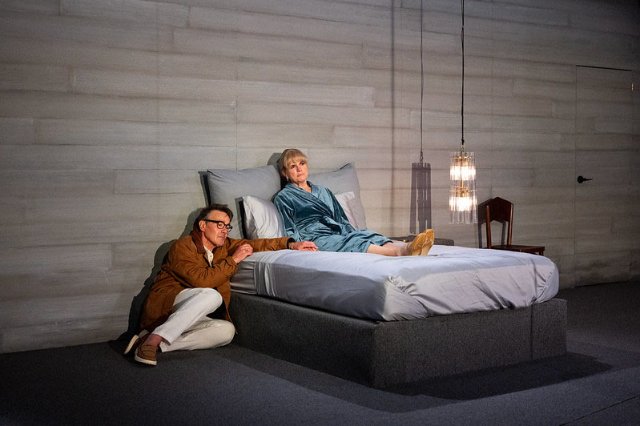A Tender Thing By Ben Power
What If Romeo and Juliet Had Survived
By: Charles Giuliano - Jun 29, 2024
A Tender Thing
By Ben Power
Directed by Alan Paul
Scenic design, Marsha Ginsberg; Costumes, Ricky Reynoso; Lighting, Robert Wierzel; Music and sound, Fabian Obispo, Movement, Mayte Natalio.
Cast: Candy Buckley (Juli), Derek Smith (Romeo)
St Germaine Stage
Barrington Stage Company
Pittsfield, Mass.
Through July 20
A Tender Thing, by Ben Power, explores an interesting premise. What if the star-crossed lovers had survived? He assembled the text by reordering and conflating excerpts of Romeo and Juliet, Twelfth Night and a number of sonnets. Hence Elizabethan language has been conveyed in a contemporary context.
The iconic deceased juvenile lovers have been reconstituted in a theatrical petri dish. Fleshed out they are then confined and displayed in an art-tight, bell jar set designed by Marsha Ginsberg.
There is the uncanny sense that Candy Buckley and Derek Smith are specimens in an experiment bringing spirits back to life. The vintage language, while authentic, is often difficult to follow making it off-putting to identify with the characters and their esoteric reincarnation.
The playwright has stripped away the back story, family feud, and supporting characters of the original play. We are left with just the lovers at mid-life sustaining their youthful passion and even facing death. It’s a full circle back to the original thorough assisted suicide.
No doubt this esoteric deconstruction would intrigue and enchant an audience of aficionados, scholars and former English majors. It appeared to be a tough fit for the audience of Barrington Stage.
In the early going it was challenging to contextualize the time, place and circumstance of the lovers. Buckley and Smith are superb actors who perform with palpable synergy.
There was a hard austerity to the minimalist set, props and lighting that channeled our vision and responses. The rather brilliant design of Ginsberg replicated an interior that might have been created by architect Tadeo Ando. He is known for poured concrete which is the look created by the flanking walls. It ends with a glass wall that overlooks the ocean. A curtain is drawn to indicate sequences of the passage of time. The set entails three entrances for costume changes, time intervals and introduction of props.
The lighting design by Robert Wierzel is stark and effective. There are five, spaced-out practicals. These cylindrical fixtures are at times raised or lowered. When close to the floor they help to define the space. The ceiling has parallel rows of fluorescents as well as small spots. Briefly, there were two, bright, red fluorescent rows.
The primary prop was a large double bed. It is here that much of the action was staged. The bed was a surrogate for sleep, fornication, and eventfully, death by poison.
As the play evolved we were drawn in by her struggle with cancer. Then the acting was more palpable as we were riveted by her pain.
There is a lot of movement in this production. The actors seem to be reflecting off of those unyielding hard surfaces. Pulled out of the original tragic romance, and thrust into middle age, we never quite comprehend who they are. To what extent are their personas not entirely theatrical and artificial? Are they real people? There is an unclear reference to a deceased daughter. What were the motivations of their day-to-day lives other than sustaining the youthful flame of love?
While an extension of the most iconic love story in the canon it is more invention than reality. That may be an inappropriate expectation but why then frame the production in present time? They might well have staged this drama in a time appropriate Italian villa.
The twist of this immortal love story is that she is ravaged by cancer. We are shocked and agonized to see the stages of her demise. When they are dancing she falls to the floor. From there we see her decline with cane, then walker, and finally a wheel chair.
She pleads with Romeo to end her suffering. He succumbs but wonders how can there be Romeo without Juliet? Having granted her wish he appears to leave. But at the door turns back. There is no future and he joins her in double suicide.
That would appear to be that. But no. After an interval they bound up and about for a cheerful post-mortem dance macabre. So this Romeo and Juliet, after all is said and done, has a happy ending.

